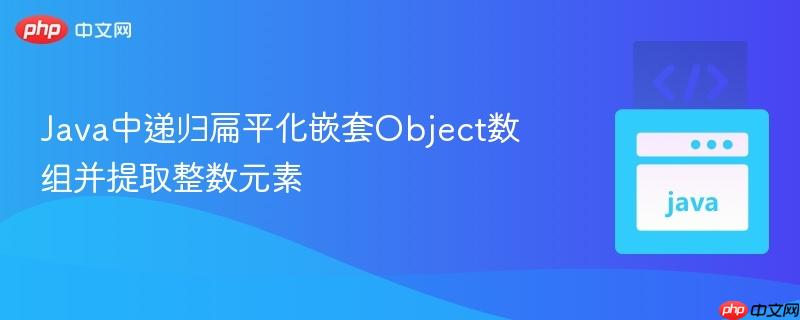
在java编程中,我们有时会遇到包含多层嵌套的object数组,其中可能混合了不同类型的数据,例如基本类型(如integer)和其他object数组。一个典型的场景是,我们需要从这样一个结构中提取所有特定类型(例如所有integer)的元素,并将它们收集到一个扁平化的列表中。
考虑以下示例数组:
Object[] array = { 1, 2, new Object[]{ 3, 4, new Object[]{ 5 }, 6, 7 }, 8, 9, 10};我们期望的结果是一个包含所有整数的扁平化数组或列表:{1, 2, 3, 4, 5, 6, 7, 8, 9, 10}。
一个简单的迭代方法,例如:
List<Integer> list = new ArrayList<>();
for(Object obj : array){
if(obj instanceof Integer) {
list.add((Integer) obj);
}
}这种方法只能处理数组的第一层元素,对于嵌套在子数组中的整数(如3, 4, 5, 6, 7)则无法触及。由于嵌套的深度可能是任意的,传统的循环结构难以有效处理,因此需要一种能够“深入”到每一层嵌套的解决方案。
立即学习“Java免费学习笔记(深入)”;
解决此类不确定深度嵌套问题的最有效方法是使用递归。递归函数通过在遇到子数组时调用自身,从而能够逐层遍历整个数据结构。
下面是实现这一递归逻辑的Java代码:
import java.util.ArrayList;
import java.util.List;
public class NestedArrayFlattener {
/**
* 递归地从嵌套的Object数组中提取所有Integer元素。
*
* @param source 源Object数组,可能包含Integer元素或其他Object数组。
* @param destination 目标List,用于存储提取出的所有Integer元素。
* @throws IllegalArgumentException 如果遇到既不是Object[]也不是Integer的意外类型元素。
*/
public static void extractIntegers(Object[] source, List<Integer> destination) {
// 遍历当前层数组中的每一个元素
for (Object element : source) {
// 使用Java 16+的模式匹配instanceof
if (element instanceof Object[] subArray) {
// 如果元素是Object数组,则递归调用自身处理子数组
extractIntegers(subArray, destination);
} else if (element instanceof Integer integerValue) {
// 如果元素是Integer,则添加到目标列表中
destination.add(integerValue);
} else {
// 处理非Integer也非Object[]的意外类型元素
// 可以选择忽略,也可以抛出异常,这里选择抛出异常以明确指出问题
throw new IllegalArgumentException("遇到意外类型元素: " + element.getClass().getName() + " -> " + element);
}
}
}
public static void main(String[] args) {
// 定义一个包含多层嵌套的Object数组
Object[] nestedArray = { 1, 2, new Object[]{ 3, 4, new Object[]{ 5 }, 6, 7 }, 8, 9, 10};
// 创建一个ArrayList来存储提取出的整数
List<Integer> integerList = new ArrayList<>();
// 调用递归方法进行扁平化和提取
extractIntegers(nestedArray, integerList);
// 打印结果
System.out.println("扁平化后的整数列表: " + integerList); // 预期输出: [1, 2, 3, 4, 5, 6, 7, 8, 9, 10]
// 示例:处理包含其他类型元素的数组
Object[] mixedArray = {1, "hello", new Object[]{2, true, new Object[]{3.14}}, 4};
List<Integer> mixedIntegerList = new ArrayList<>();
try {
extractIntegers(mixedArray, mixedIntegerList);
System.out.println("混合数组中的整数列表: " + mixedIntegerList);
} catch (IllegalArgumentException e) {
System.err.println("处理混合数组时发生错误: " + e.getMessage());
}
}
}extractIntegers(Object[] source, List<Integer> destination) 方法:
main 方法:
if (element instanceof Object[]) {
Object[] subArray = (Object[]) element;
extractIntegers(subArray, destination);
} else if (element instanceof Integer) {
Integer integerValue = (Integer) element;
destination.add(integerValue);
}通过上述递归方法,我们可以优雅且高效地处理Java中任意深度的嵌套Object数组,并从中提取所需的特定类型元素。这种模式在处理树形结构或类似层级数据时非常常见且强大。
以上就是Java中递归扁平化嵌套Object数组并提取整数元素的详细内容,更多请关注php中文网其它相关文章!

每个人都需要一台速度更快、更稳定的 PC。随着时间的推移,垃圾文件、旧注册表数据和不必要的后台进程会占用资源并降低性能。幸运的是,许多工具可以让 Windows 保持平稳运行。

Copyright 2014-2025 https://www.php.cn/ All Rights Reserved | php.cn | 湘ICP备2023035733号